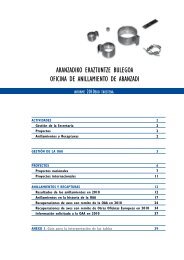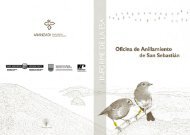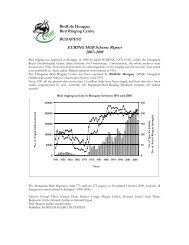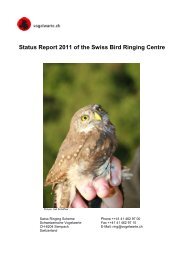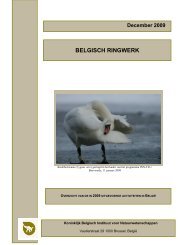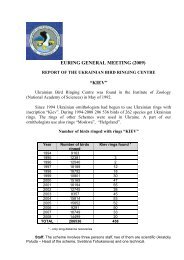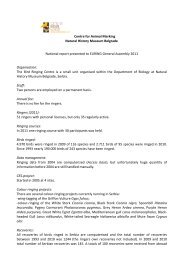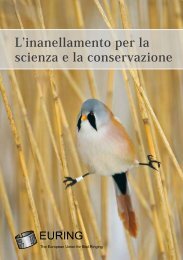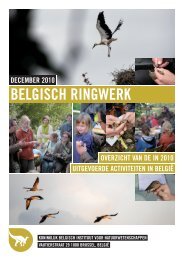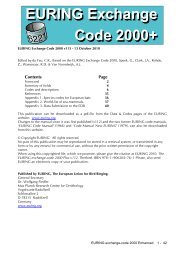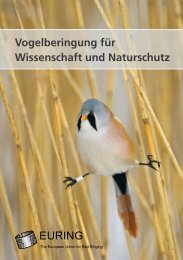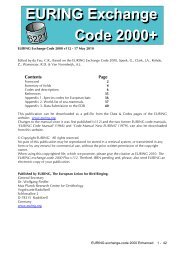The quantitative study of marked individuals in ecology, evolution ...
The quantitative study of marked individuals in ecology, evolution ...
The quantitative study of marked individuals in ecology, evolution ...
Create successful ePaper yourself
Turn your PDF publications into a flip-book with our unique Google optimized e-Paper software.
EURING 2003 Radolfzell<br />
• Comb<strong>in</strong>ed Survival-Transition probabilities can be represented as such or decomposed<br />
<strong>in</strong>to transition and survival probabilities (Hestbeck, Nichols et al. 1991).<br />
• Among the transition probabilities with the same state <strong>of</strong> departure, the one to be<br />
computed as 1 m<strong>in</strong>us the others can be freely picked by the user. User-friendl<strong>in</strong>ess is<br />
enhanced by the eas<strong>in</strong>ess with which constra<strong>in</strong>ed models are built, us<strong>in</strong>g a language,<br />
<strong>in</strong>terpreted by a generator <strong>of</strong> design matrices called GEMACO. This language is alike<br />
those <strong>in</strong> general statistical s<strong>of</strong>tware such as SAS or GLIM, i.e., a formula such as t+g<br />
generates a model with additive effects <strong>of</strong> time and group, thus avoid<strong>in</strong>g tedious and<br />
error-prone matrix manipulations us<strong>in</strong>g an editor or a spread-sheet. Examples <strong>of</strong> various<br />
types <strong>of</strong> multistate models are developed and presented.<br />
You can download M-Surge freely from ftp.cefe.cnrs-mop.fr/biom/S<strong>of</strong>t-CR.<br />
03:10 PM - 03:45 PM<br />
DENSITY: s<strong>of</strong>tware for fitt<strong>in</strong>g spatial detection functions to data from passive<br />
sampl<strong>in</strong>g<br />
Murray Efford & Deanna Dawson<br />
Rigorous sampl<strong>in</strong>g <strong>of</strong> bird populations to estimate density raises the problem <strong>of</strong> <strong>in</strong>complete<br />
detection (e.g., Pollock et al. 2002). Vary<strong>in</strong>g detectability is widely acknowledged,<br />
but variation <strong>in</strong> its spatial component (how detection decl<strong>in</strong>es with distance) is<br />
considered less <strong>of</strong>ten. Active methods (double sampl<strong>in</strong>g and distance sampl<strong>in</strong>g) require<br />
an observer to determ<strong>in</strong>e the <strong>in</strong>stantaneous distance between the sampl<strong>in</strong>g<br />
po<strong>in</strong>t and each animal. Passive methods (mistnets or traps) rely on animals mov<strong>in</strong>g to<br />
the detector: <strong>in</strong>stantaneous locations are unknown, and movement is an important<br />
unmeasured component <strong>of</strong> detectability.<br />
New methods have been developed to fit spatial detection functions to capturerecapture<br />
data from passive detectors. <strong>The</strong> methods are computer-<strong>in</strong>tensive and depend<br />
on specialised s<strong>of</strong>tware ('DENSITY'), available for download at<br />
www.landcareresearch.co.nz. DENSITY provides a graphical <strong>in</strong>terface for the analysis<br />
<strong>of</strong> closed-population capture-recapture data from arrays <strong>of</strong> passive detectors. Its<br />
simulation capability enables users to perform power analysis <strong>of</strong> different sampl<strong>in</strong>g<br />
designs before go<strong>in</strong>g <strong>in</strong>to the field.<br />
We demonstrate the use <strong>of</strong> DENSITY to estimate bird population density from mist<br />
nett<strong>in</strong>g data. Nett<strong>in</strong>g was conducted over 1992 to 1996 on a forest-pasture ecotone <strong>in</strong><br />
Mexico. In each <strong>of</strong> 16 nett<strong>in</strong>g sessions, six local arrays <strong>of</strong> 20 nets were run for 2-3<br />
consecutive days. Despite the large number <strong>of</strong> captures <strong>in</strong> total, with<strong>in</strong>-session recaptures<br />
were rare for most species. This restricted application <strong>of</strong> the method to a few<br />
common species (e.g. Sporophila torqueola) and to species aggregates (e.g. 'w<strong>in</strong>ter<br />
residents'). Although the use <strong>of</strong> the method for mist nett<strong>in</strong>g data was experimental, it<br />
may lead through simulation <strong>in</strong> DENSITY to improved design <strong>of</strong> mist net arrays where<br />
density estimation is a <strong>study</strong> goal.<br />
<strong>The</strong> spatially explicit framework <strong>of</strong> DENSITY opens up new possibilities and we expect<br />
the s<strong>of</strong>tware to evolve. An excit<strong>in</strong>g prospect is the direct fitt<strong>in</strong>g <strong>of</strong> simple density<br />
surfaces dur<strong>in</strong>g estimation, given suitable spatial covariates.<br />
23



